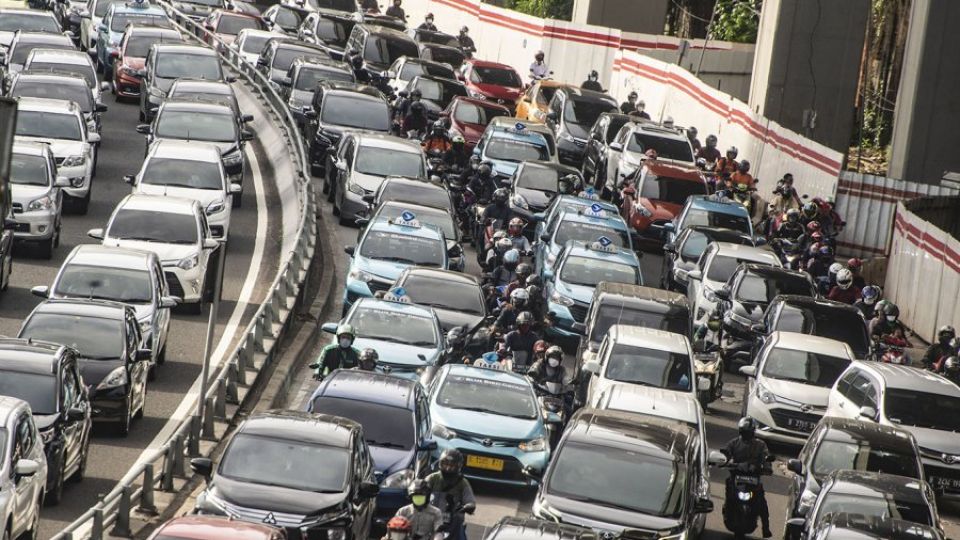August 23, 2023
JAKARTA – People in Jakarta love their cars and these folks love their big, gas-guzzling, black-tinted SUVs to the point of absurdity.
For the majority of white-collar workers in Jakarta, spending at least four hours per day inside their cars, traveling at a maximum speed of 20 kilometers per hour is still the best way to commute, as it can provide them with shelter from the city’s punishing heat and the polluted air of their own making. (Although studies have shown that the pollution level inside a car is actually often higher than the environment around them, so the sense of shelter from the air quality outside is actually an illusion).
For most of the wealthy and the well-heeled, being chauffeured around in one of those bulky SUVS and being dropped off at the exact point of their destination is a status symbol.
For these people, it seems like nothing can give them a sense of self-worth more than being saluted by security guards or lobby-boy at the city’s swanky hotels and shopping malls who open the door for them.
For them, it is better to be late for lunch or dinner due to traffic than having to exit their cars and walk to their destination. If you are curious why traffic congestion always occurs in the vicinity of shopping malls, this is likely the reason.
And if you wonder why the traffic is mostly worst in the morning, blame those middle-class parents who want to show love and affection to their kids by shipping them off to school in an air-conditioned private sedan or SUV.
For the majority of people in the middle-to-low income bracket, especially non-Jakarta natives, owning a car is again a status symbol, a sign of success that they have made it in the big city.
These people may have lived in slums or poor neighborhoods with no space to park their vehicles, but at least once a year they can drive these cars back to their hometowns and show them off to their parents and next of kin. Hence the annual traffic headache during holiday season.
This preoccupation with cars has brought negative effects for all of us, with the worsening air quality we are currently experiencing one of the main problems.
There is a debate over whether the poor air quality we are having today is the effect of dozens of coal-powered power stations operating in the vicinity of the capital or whether the exhausts of cars plying the city’s streets everywhere all the time throughout the day is to blame for the pollution.
Whatever the answer to the question, we can certainly expect that with fewer cars on the road, things could improve fast.
We know that car culture has created a problem. Many studies have shown us the cost of traffic congestion to our economy, physical health and our sanity. It is almost pointless to show you the figures of loss growth and loss of productivity caused by traffic jams, when you can feel it in your lungs that pollution has taken its toll on your well-being.
The government knows about this and they know very well that there are a range of policy options that they can take, from imposing mandatory emission tests and applying road-pricing policy to slapping a progressive tax on the purchase of new cars.
Of course, we cannot expect carmakers, whose main interest is to sell faster and bigger cars, to help us with our car addiction problem, so it is incumbent upon the government to take drastic measures, especially now as we are teetering on the brink of an environmental catastrophe.
But the problem is that the government today treats the car manufacturing industry as the country’s saving grace.
People in the government, whom you can see most days being chauffeured around in the most expensive German cars, know very well about the country’s car addiction and adopt the policy that fuels the fire of the addiction.
Year after year, the government sets targets for carmakers to sell more cars, with alarms being raised if these companies, mostly Japanese, fail to reach their target.
Senior cabinet ministers if not the President himself come to inaugurate trade shows like the Association of Indonesian Automotive Manufacturers (Gaikindo) Indonesia International Auto Show (GIIAS) and the Indonesia International Motor Show, lending weight and prestige to the industry.
The size of crowds that gather for trade shows and the number of on-site transactions have become the indicator of the health of the country’s overall economy.
In this year’s GIIAS, the government expects that Rp 15 trillion (US$100 million)-worth of orders will be placed, more than the Rp 14.3 trillion reported last year.
Also this year, Gaikindo projects that brands can sell 1.05 million cars up from 975,000 units in 2022. Already, in the first three months of this year alone, the number of cars sold reached 271,168 units, up 13 percent from the same period last year.
So far so good. All is well in the land of cars.
For car manufacturers, the figures are abstract calculations drawn up to project profits and dividends for their shareholders.
For car lovers, the figures represent more options on models and price ranges that they can add to their collection.
For the majority of us, this will mean urban air quality dropping to even more toxic levels and, if we can live with it, an even longer commute to work.
We don’t know how long we can survive this.
***
The writer is editor-in-chief of The Jakarta Post.


